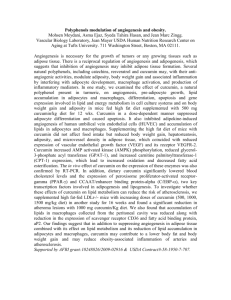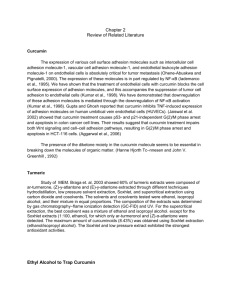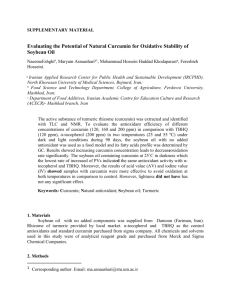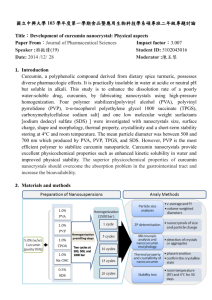Supplementary Information (doc 48K)
advertisement
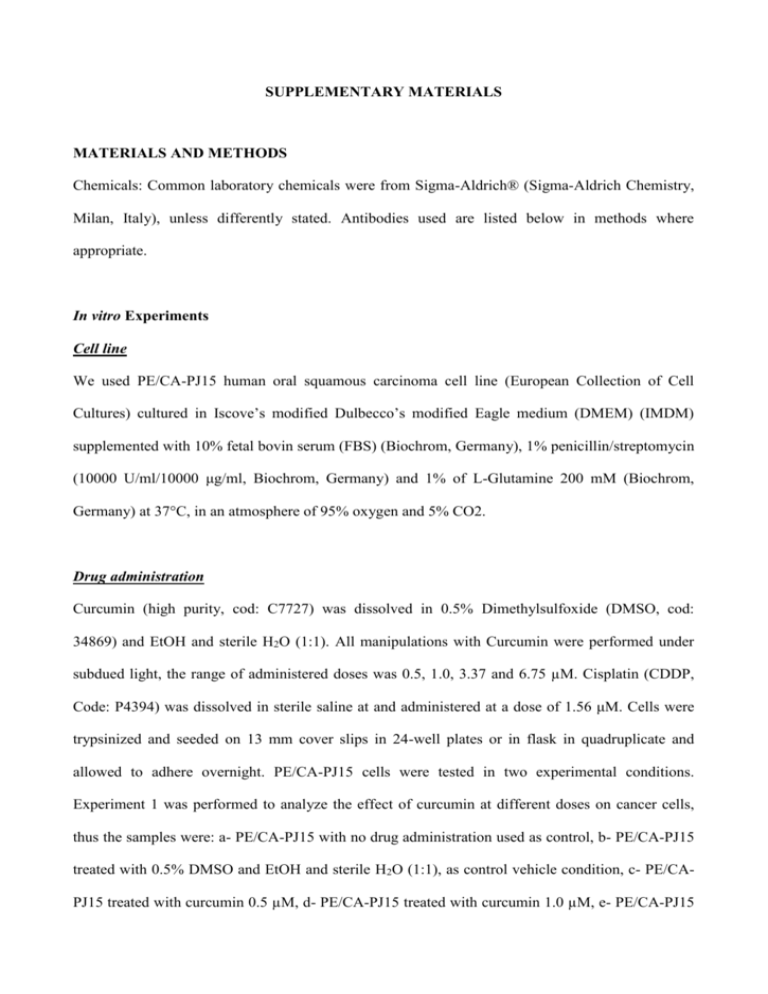
SUPPLEMENTARY MATERIALS MATERIALS AND METHODS Chemicals: Common laboratory chemicals were from Sigma-Aldrich® (Sigma-Aldrich Chemistry, Milan, Italy), unless differently stated. Antibodies used are listed below in methods where appropriate. In vitro Experiments Cell line We used PE/CA-PJ15 human oral squamous carcinoma cell line (European Collection of Cell Cultures) cultured in Iscove’s modified Dulbecco’s modified Eagle medium (DMEM) (IMDM) supplemented with 10% fetal bovin serum (FBS) (Biochrom, Germany), 1% penicillin/streptomycin (10000 U/ml/10000 μg/ml, Biochrom, Germany) and 1% of L-Glutamine 200 mM (Biochrom, Germany) at 37°C, in an atmosphere of 95% oxygen and 5% CO2. Drug administration Curcumin (high purity, cod: C7727) was dissolved in 0.5% Dimethylsulfoxide (DMSO, cod: 34869) and EtOH and sterile H2O (1:1). All manipulations with Curcumin were performed under subdued light, the range of administered doses was 0.5, 1.0, 3.37 and 6.75 µM. Cisplatin (CDDP, Code: P4394) was dissolved in sterile saline at and administered at a dose of 1.56 μM. Cells were trypsinized and seeded on 13 mm cover slips in 24-well plates or in flask in quadruplicate and allowed to adhere overnight. PE/CA-PJ15 cells were tested in two experimental conditions. Experiment 1 was performed to analyze the effect of curcumin at different doses on cancer cells, thus the samples were: a- PE/CA-PJ15 with no drug administration used as control, b- PE/CA-PJ15 treated with 0.5% DMSO and EtOH and sterile H2O (1:1), as control vehicle condition, c- PE/CAPJ15 treated with curcumin 0.5 µM, d- PE/CA-PJ15 treated with curcumin 1.0 µM, e- PE/CA-PJ15 treated with curcumin 3.37 µM and f- PE/CA-PJ15 treated with curcumin 6.75 µM. Experiment 2 was performed to analyze the combined effect of curcumin and CDDP administration, thus the samples were: a- PE/CA-PJ15 with no drug administration used as control, b- PE/CA-PJ15 treated with CDDP (1.56 µM), c- PE/CA-PJ15 treated with CDDP and curcumin 0.5 µM, d- PE/CA-PJ15 treated with CDDP and curcumin 1.0 µM, e- PE/CA-PJ15 treated with CDDP and curcumin 3.37 µM, f-PE/CA-PJ15 treated with CDDP and curcumin 6.75 µM. Each experiment was repeated three times and we ran 4 replicates for each sample. Not significant differences were observed between control (not treated) and control vehicle cells (data not shown). Cisplatin, curcumin and DMSO were purchased from Sigma-Aldrich®. Cell survival In order to evaluate the toxic effect of curcumin, cisplatin and the combined drug exposure, 1.0×10 4 cells/glass were fixed with 4% paraformaldehyde for 15 minutes, washed twice in PBS and then incubated in a solution containing DAPI (1:1000 in PBS 0.1 M) and Triton (TX, 0.1% in PBS 0.1 M) for 10 minutes light-protected and at room temperature. DAPI labelling was used to identify condensed cell nuclei. The sample were, then, washed in PBS and coverslipped with an antifade medium (ProLong Gold; Invitrogen). Cell count was performed on image acquired (10×) and processed with the aid of ImageJ Nucleus Counter Plugin (WCIF ImageJ, from http://www.uhnres.utoronto.ca/facilities/wcif/). Each count was based on 10 fields randomly selected for each of the experimental condition. Moreover, images were taken at higher magnification (40x) by a confocal laser scanning microscope (TCS-SP2; Leica Microsystem, GmbH, Wezlar, Germany). To highlight changes in morphology like swelling, nuclear condensation and cellular fragmentation, DAPI staining was imaged by two-photon excitation (740 nm, < 140 fs, 90 MHz) performed by an ultrafast tunable mode-locked titanium:sapphire laser. pSTAT3 and Nrf-2 Immunofluorescence In order to perform immunofluorescence for the molecular targets, Nrf-2 and pSTAT3, cells were fixed with 4% paraformaldehyde for 15 minutes at room temperature, permeated with 0.1% TX for 15 minutes prior to being blocked in 0.3% BSA for 20 min. Samples were then incubated with primary antibodies rabbit anti-phospho-STAT3 (Tyr705) (Cell signaling, Tech, Boston, MA, USA) and mouse anti-Nrf-2 (Abcam, Cambidge, UK) for 3 h in 0.3% BSA in PBS. At the end of incubation, all samples were washed twice in PBS and incubated at room temperature for 90 minutes, light-protected, with secondary antibody diluted 1:1000 in PBS. To detect pSTAT3 and Nrf-2 we used goat anti-rabbit 488 (Alexa Fluor) and donkey anti-mouse 546 (Alexa Fluor) respectively. Moreover, cell nuclei were counterstained with DAPI (1:1000 in PBS) for 10 min at room temperature, light-protected. Then, the samples were coverslipped with an antifade medium (ProLong Gold; Invitrogen). Images of pSTAT3 and Nrf-2 immunolabelled specimens (40×) were taken by the confocal laser scanning microscope equipped with an argon/argon– krypton laser and a helium/neon laser for 488 and 519 excitation. DAPI staining was imaged by two-photon excitation (740 nm, <140 fs, 90 MHz) performed by an ultrafast tunable mode-locked titanium:sapphire laser. pSTAT3, Nrf-2 and DAPI positive cells were identified by green, red and blue fluorescence respectively. To quantify Nrf-2 and pSTAT3 fluorescence signal, we performed optical density analysis in the cytoplasmic and nuclear compartment by using Leica Confocal Software (LCS Lite). Immunofluorescence was performed 24, 48 and 72h after treatment. However, given that no significant differences were observed among the three time points, only the results at 24h are discussed. TUNEL Assay Apoptosis was evaluated in PE-CA/PJ15 cultures with the APO-BrdU TUNEL assay kit (Invitrogen) 48h after treatment, according to the manufacturer’s instructions, as previously described (Piacentini et al, 2008). Briefly, DNA strand breaks in apoptotic cells were labeled with BrdU by the use of terminal deoxynucleotide transferase. Apoptotic cells were identified immunocytochemically by means of anti-BrdU antibody labelling with Alexa Fluor 488 dye, and cell nuclei were identified by means of propidium iodide/RNase staining. Western blot PE/CA-PJ15 cells (2x106) were trypsinized 48 h after drug treatment and then centrifuged at 500×g for 5 minutes. Protein concentration was measured using a Micro BCA kit (Pierce). An equal amount of sample (30 μg) was separated by 10% SDS-PAGE and then electrophoretically transferred onto 0.45 μm nitrocellulose membranes using a solution containing 50 mM Tris/HCl, 380 mM glycine, and 20% methanol 1h at 4°C. Afterwards, a Ponceau S staining was performed to ensure protein transfer (ICN Biochemicals). Nonspecific binding sites were blocked with 5% dry milk in Tris-buffered saline (TTBS; 20 mM Tris, 500 mM NaCl, and 0.05% Tween 20). Next, the membranes were incubated overnight at 4°C with the primary antibody anti- Bax (Immunological Science, Rome, Italy) diluted (1:400) in 3% BSA and 0.05% NaN3/TTBS. After five rinses in buffer, membranes were incubated for 1h at room temperature with a horseradish peroxidase conjugated anti-mouse IgG secondary antibody (Cell signaling, Tech, Boston, MA, USA) that was diluted 1:2500 in 2.5% dry milk/TTBS. Blots were developed using enhanced chemiluminescence reagents (ECL; GE Healthcare). Equal protein loading among individual lanes was confirmed by reprobing the membranes with an anti-α-actin mouse monoclonal antibody at a 1:1000 dilution (Thermo Fisher Scientific). Protein expression was evaluated and documented by using UVItec Cambridge Alliance. The experiments were repeated three times, and an inter experiment variability of <10% was found. In vivo Experiments Animals Male adult Wistar rats (UCSC Laboratories, 200-250 gr) were used. The auditory function of each animal was tested for the presence of Preyer’s reflex. The experiments were performed on 25 animals, randomized and assigned to 4 experimental groups as follows: 1- control (Ctrl; n= 5); 2Cisplatin (CDDP; n= 5); 3- Cisplatin+Curcumin at a dose of 100 mg/kg (CDDPCur 100; n= 5); 4Cisplatin+Curcumin at a dose of 200 mg/kg (CDDPCur 100; n= 5) and 5- Cisplatin+Curcumin at a dose of 400 mg/kg (CDDPCur 400; n= 5). All animals were sacrificed under deep anesthesia (ketamine at dose 70 mg/kg and medetomidine-dormitor at dose of 0.5 mg/kg) at day 5 after treatment onset. For the whole experimental period, the animals were housed 2 per cage at controlled temperature (22/23°C) and constant humidity (60±5%), under a 12-hour light/dark cycle, with food (Mucedola 4RF21, Italy) and water ad libitum. All efforts were made to minimize animal suffering and to reduce their number, in accordance with the European Community Council Directive of 24 November 1986 (86/609/EEC). All procedures were performed in compliance with the Laboratory of Animal Care and Use Committee of the Catholic University, School of Medicine of Rome and were approved by the Italian Department of Health (Ministero della Salute). Drug administration As described previously (Fetoni et al, 2014), curcumin was dissolved in DMSO. The diluted solution was prepared freshly daily and administered intraperitoneally (i.p.) at three different doses (100, 200 and 400 mg/Kg b.w.). Curcumin solution was injected 1 hour before cisplatin administration and once daily for the following 3 days. Cisplatin, diluted in sterile saline (1 mg/ml), was prepared freshly and protected by light. To facilitate the dissolution of cisplatin, the solution was heated and stirred for a period of 20 minutes. Under deep anaesthesia, a single cisplatin dose of 16 mg/Kg (Fetoni et al, 2014) was delivered i.p. at a rate of 8 ml/h with an infusion pump (Axon Instruments, Foster City, CA, USA) over about 30 minutes. The animals were hyper-hydrated with saline solution (subcutaneous injection, 15 ml daily) to limit cisplatin side effects. Auditory Function Evaluation Auditory Brainstem Responses (ABR) Hearing level induced by treatments (cisplatin and curcumin) was estimated by ABR recordings, in order to identify the acoustic threshold of each animal for each group. ABRs were measured at low (6 kHz), mid (12, 16, and 20 kHz), and high (24 and 32 kHz) frequencies. In all animals, ABRs were assessed bilaterally before treatment (day 0) to assure normal hearing and reassessed at all time points (3 and 5 days from treatment onset) to evaluate the effect of treatments on hearing. All animals were mildly anesthetized (ketamine, 35 mg/kg and medetomidine-dormitor, 0.25 mg/kg) and placed in the anechoic room. As described previously (Fetoni et al, 2013; 2014), 3 stainless steel recording electrodes were subcutaneously inserted posterior to the tested pinna (active), vertex (reference), and contralateral pinna (ground). A PC-controlled TDT System 3 (Tucker-Davis Technologies, Alachua, FL, USA) data acquisition system with real-time digital signal processing was used for ABR recording and auditory stimulus generation. Tone bursts of pure tones from 6 to 32 kHz (1 ms rise/fall time, 10 ms total duration, 20/s repetition rate) were presented monaurally. Responses were filtered (0.3-3 kHz), digitized, and averaged (across 500 discrete samples at each frequency-level combination). Threshold value was defined as the lowest stimulus level that yielded a repeatable waveform-based onset. Distortion product otoacoustic emissions (DPOAEs) To determine the effect of cisplatin ototoxicity on OHC function, DPOAEs were measured unilaterally using an otoacoustic emission system (Tucker-Davis Technologies, Alachua, FL, USA). The f2/f1 ratio of the primary tones was set to 1.2. DPOAE input/output functions were measured at f2 frequencies of 4, 8, 12, 16 and 20 kHz. The f1 intensity (L1) always presented +10 dB above the f2 intensity (L2). Animals were anaesthetized as described above for ABR procedure and placed on a heating pad in a sound-attenuating booth. The probe assembly was placed in the animal's external ear canal. Input/output functions were obtained by increasing L1 intensity from 20 to 70 dB SPL at f2 frequencies of 4, 8, 12, 16 and 20 kHz (32 sweeps per frequency pair). DPOAEs were recorded before and 3 and 5 days after the onset of treatment. Morphological analyses and cell viability The Rhodamine-Phalloidin (Rh-Ph), a high affinity F-actin probe conjugated to the red-orange fluorescent dye, tetramethylrhodamine (TRITC), was used to visualize the stereociliary arrays and cuticular plates of hair cells. Rh-Ph staining was performed at day 5 in 5 cochleae/group animals. As described previously (Fetoni et al, 2014), surface preparations of the organ of Corti were incubated with a solution containing 0.5% Triton X-100 and Rh-Ph (1:100 dilution; Molecular Probes, Invitrogen, Carlsbad, CA, USA) in 0.1 M PBS for 1 hour at room temperature protected from light. Positive cells were counted in segments of approximately 250 µm in length each along the basilar membrane. Hair cells were considered missing if both the stereocilia bundles and the cuticular plates were absent, and OHC loss was calculated as percentage with respect to controls. All morphologic observations were performed with the aid of the confocal laser scanning system. Nrf-2/ HO-1 and pStat3 Immunostainings Immunostainings were performed at day 5 in cochlear cryosections (12 m), in order to assess and quantify the endogenous antioxidant response to cisplatin-induced damage and to evaluate the effect of curcumin supplementation. As described previously (Fetoni et al, 2013, 2015), the cochleae (5/group) were quickly removed, and the samples were fixed with 4% paraformaldehyde in PBS at 4°C and a pH 7.5. Next, the cochleae were decalcified for 15 d in EDTA (10% EDTA, changed daily), incubated for 48 h in sucrose (30%), embedded in OCT, and cryosectioned at a thickness of 12 μm (Cryostat SLEE). The specimens were incubated with a blocking solution (1% BSA, 0.5 % Triton x-100 and 10% normal goat serum in PBS 0.1 M) and then the slices were incubated overnight at 4 °C with a solution containing anti-HO-1 or Nrf-2 or anti-Phospho-STAT3 primary antibodies diluted 1:100 in PBS (anti-HO-1: Stressgen, Ann Arbor, MI, USA; anti-Nrf-2 and antipSTAT3: as above reported). These antibodies cross-reacted with rat tissue. All specimens were incubated at room temperature for 2 h in labeled conjugated goat anti-rabbit (HO-1 and pSTAT3) and donkey anti-mouse (Nrf-2) secondary antibody (Alexa Fluor 488 and 546, IgG, Invitrogen) diluted 1:400 in 0.1 M PBS and DAPI stained (1:500 in 0.1 M PBS). Confocal Z-stacks in series of 15-20 µm-thick were acquired as images of 1024×1024 pixels, reordered at intervals of 0.5 µm, in order to evaluate the real extent of the nuclear and/or cytoplasmatic fluorescence of HO-1, Nrf2 and pSTAT3 in high magnifications of the organ of Corti and SGNs (Fetoni et al, 2015). Images (100×) were obtained with the confocal laser scanning system equipped with an Ar/ArKr laser (for 488 nm excitation) and HeNe laser (for 543 nm excitation). DAPI staining was imaged by two photon excitation (740 nm, <140 fs, 90 MHz) performed with an ultrafast, tunable mode-locked Ti:sapphire laser. Control experiments (negative controls not shown) were performed by omitting the primary antibody during processing of tissue randomly selected across experimental groups. Tissues from all groups were always processed together during the procedures to limit variability related to antibody penetration, incubation time, post-sectioning age, and condition of tissue. Statistical Analysis Results are presented as means ± mean standard error (SEM), and differences were assessed using variance analysis (ANOVAs). As regard cell survival and proliferation a two-way ANOVA was performed (group×time point). To analyze TUNEL-positive cells, one way ANOVA was performed. ABR and DPOAEs data were evaluated by three-way ANOVA (ABR: group×frequency×time point; DPOAEs: group×dB×time point). Cochleogram data were analyzed by two-way ANOVA (group×cochlear turn). Post-hoc comparisons were assessed using Tukey’s test (Statistica, Statsoft, Tulsa, OK, USA); p< 0.05 was considered significant. The magnitude of tumour progression was expressed as percentage of the ratio of survived cells (cell relative viability%= experiment values/control*100%) among times points (p<0.05).

